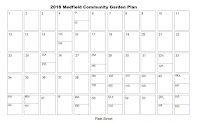The end of the gardening season is always abrupt. One day you have a thriving vegetable plot. Then, via the simple expedient of an overnight
frost, it turns to mush. Your annuals
succumb to frost and old age. Your
perennials look fine and are in flower.
Then, for no ascertainable reason, they’re brown.
 |
| Mother nature has wreaked havoc with our garden clean-up schedule |
As conscientious stewards of the land, Betty and I
strive each year to put each of our gardens to bed in an orderly fashion. This year, Mother Nature has been mucking
with the calendar.
What do I mean?
Let’s take pine cones as an example.
We had a wet summer and the pines at the borders of our property
rewarded us with a bumper crop of cones.
We picked every last one out of the garden – more than a thousand cones –
in late September. Why do we bother? Well, for one thing we don’t want a pine
forest sprouting in our garden. Just as
important, though, pine cones are food for squirrels and other unwanted
rodents. But then came a surprise nor’easter. The pine cones re-appeared in the garden as
if by magic. We picked them up
again. Last week, a storm with
gale-force winds blew through. Another
pine-cone-picking party.
 |
| A nor'easter brought us a second plague of pine cones |
We took down our vegetable garden as plants ran their
course. The stalks from three squares of
corn, for example, were taken out as the last ears were picked. But, in the absence of frost, some plants
kept producing (we had zucchini and tomatoes into late October). The ogre who runs our community garden requires
plots to be cleared by the end of October.
As a result, much of our final vegetable garden cleanup was hurriedly done
on the last day of the month. A week
later, in our capacity as overseers of the community garden, we were back out
to clean up the detritus of three abandoned plots. Naturally, it rained. Fortunately, seven volunteers made the work
go much more quickly.
| In addition to clearing our own plot we cleaned abandoned ones... in the rain |
Our first hard frost (October 20) took out our
container gardens – twelve ‘major’ ones and another twelve ‘minor’ ones. Each container had to be emptied, the vegetative
matter taken to the transfer station, the potting mix added to a low spot, the
miscellaneous bottles and other ‘ballast’ in the containers cleaned; and the
containers themselves bleached, washed and put away in the basement. That was a three-day process.
On October 21, UPS came calling with our fall bulb
order – 500 of them. We set it
aside. The trick with bulbs is they must
be planted early enough that they can still generate roots, but not so early
that they’ll produce greens. If the
ground begins to freeze, it’s likely too late to plant and you’ve just wasted
beaucoup dollars.
| Racing to get bulbs planted |
We began taking down the multiple-hundreds of
perennials that form the heart of our garden in late October… which is also
when it began to rain in earnest. We
would cut back amsonia, baptisia, eupatorium and the like for a few hours; then
watch as the clouds darkened. This hide-and-seek
with the rain went on for the better part of a week.
Finally, last Saturday, we could wait no longer. Starting just after dawn, and with a forecast
of heavy precipitation for the afternoon, we began digging out six large spaces
for our new bulbs. Everything was
excavated to a depth of five to seven inches, bulbs were placed, then a parfait
of limestone and soil layers were added and topped with mulch. The rain started just as we patted down the
last bulb patch.
 |
| We've had triple our normal rainfall |









